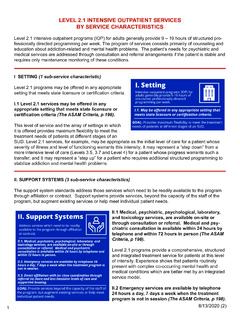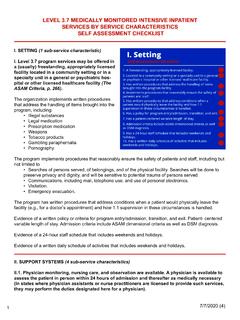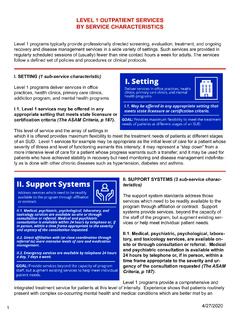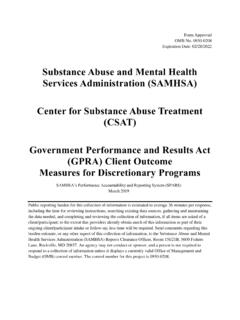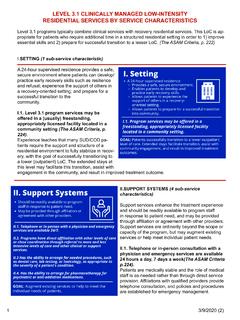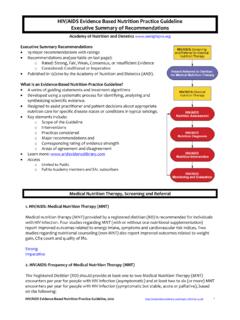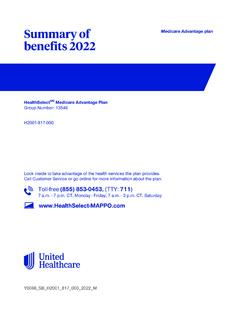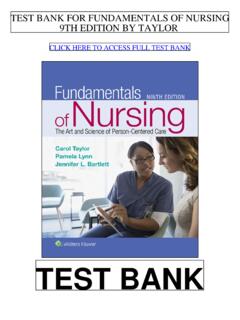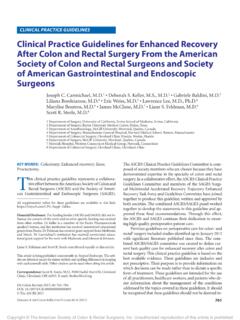Transcription of 3.5 Service Characteristics - Pennsylvania Department of ...
1 LEVEL CLINICALLY MANAGED HIGH-INTENSITY RESIDENTIAL SERVICESBY Service CHARACTERISTICSL evel programs assist patients whose addiction is currently so out of control that they need a 24 hour supportive treatment environment to initiate or continue a recovery process that has failed to progress. (The ASAM Criteria, p. 244)I. SETTING (1 sub- Service characteristic)The Level offers 24-hour supportive treatment in a contained, safe, and structured environment to help patients initiate or continue a recovery process that has failed to Level program services may be offered in a (usually) freestanding, appropriately licensed facility located in a community setting or a specialty unit within a licensed healthcare facility.
2 Some Level programs are offered in prisons or secure community settings as a step down for those inmates released from prison. (The ASAM Criteria, ).Experience teaches that new skills are required for a successful transition from active addiction to a stable, recovery-positive lifestyle. The residential setting provides structure, supervision, and support in this effort. Level programs may be found in freestand-ing facilities, within larger institutions, or in correctional environments, so long as requirements are SUPPORT SYSTEMS (3 sub- Service Characteristics )The support system standards address those services which need to be readily available to theprogram through affiliation or contract.
3 Support systems provide services, beyond the capacity of the staff of the program, which will not be needed by patients on a routine basis or services to augment those provided by Telephone or in-person consultation with a physician, or a physician assistant, or a nurse practitioner in states where they are licensed as nurse extenders, and may perform the duties designated there for a physician; emergency services, available 24 hours a day, 7 days a week (The ASAM Criteria, ).It is assumed that the Level program will require 13/9/2020 (3)assistance from outside providers to meet the many and diverse needs of SUD/COD patients. Through affiliations and agreements, the program ensures access to qualified licensed providers and can monitor quality of services Level programs have direct affiliations with other levels of care, or close coordination through referral to more and less intensive levels of care and other services ( , vocational as-sessment and training, literacy training, and adult education (The ASAM Criteria, p.))
4 249).For true continuity, the program establishes linkages with affiliated providers at both higher and lower levels of care. This facilitates smooth communication and careful cooperation among providers as the patient transitions to an autonomous, recovery-positive lifestyle in the The program has arranged for medical, psychiatric, psychological, laboratory, and toxicology services, as appropriate to the severity of the patient s condition (The ASAM Criteria, p. 249).Patients often require services beyond the program s capacity, and ready access may be provided through affiliation or agreement with qualified providers of medical, mental health, lab and toxicology services, among STAFF (3 sub- Service Characteristics )ASAM staff standards address the composition and competencies of professionals on the staff of the Licensed or credentialed clinical staff, such as addiction counselors, social workers, and licensed professional counselors (LPCs), who work with the allied health professional staff in an interdisciplinary team approach (The ASAM Criteria, p.
5 250).Experience teaches that treatment at Level is best delivered by a multidisciplinary team that includes both licensed/credentialed clinicians and allied staff. Competencies should be established for each role within the Allied health professional staff, such as counselor aides or group living workers, on-site 24 hours a day or as required by licensing regulations. One or more clinicians with competence in the treatment of substance use disorders are available on-site or by telephone 24 hours day. (The ASAM Criteria, p. 250)In accordance with licensing, residential programs provide 24 hour coverage using allied staff, supplemented by the ability to promptly access qualified clinicians for advice and (3) Clinical staff knowledgeable about the biological and psychosocial dimensions of substance use and mental health disorders and their treatment.
6 They can identify the signs and symptoms of acute psychiatric conditions, including psychiatric decompensation. Staff have specialized train-ing in behavior management techniques (The ASAM Criteria, ).Quality of care depends on clinical staff who possess substantial knowledge of SUDs and COD, as well as the ability to recognize and respond to psychiatric disorders and distress. Training in behavior manage-ment and crisis prevention is THERAPIES (12 sub- Service Characteristics )ASAM therapies standards cover the range of therapies that programs need to be capable of offering to ensure they meet the personalized biopsychosocial needs of the patients they treat.
7 Not all listed thera-pies must be provided to each person served, but the program should have the capacity to provide each of these as needed, and each day should include activities designed to meet the needs of the patients as defined in their individual treatment Daily clinical services to improve the patient s ability to structure and organize the tasks of daily living and recovery ( , personal responsibility, personal appearance, and punctuality) and to develop and practice prosocial behaviors (The ASAM Criteria, p. 251).Individual patients have different needs and preferences with respect to therapeutic activities and pro-gramming. The Level provider should respond with an assortment of evidence -based interventions to assist the clinician and patient in implementing the treatment plan.
8 Daily activity schedules should seek to reflect this diversity of needs and Planned clinical program activities to stabilize and maintain stabilization of the patient s ad-diction symptoms, and to help him or her develop and apply recovery skills. Activities may include relapse prevention, exploring interpersonal choices, and development of a social network support-ive of recovery (The ASAM Criteria, p. 251). evidence -based approaches with demonstrated effectiveness are available for use in addressing common issues in recovery. The program should address key topics such as preventing relapse, effective deci-sion-making, and use of community-based services and supports, among counseling and clinical monitoring to promote successful initial involvement or re- involve-ment in regular, productive daily activity ( , work or school) and, as indicated, successful reinte-gration into family living (The ASAM Criteria, p.)
9 25).The Level therapeutic milieu allows for practice of recovery-positive living skills, including adherence to a schedule of productive daily activities. Family participation in treatment should also be encouraged, as it can improve family coping skills for early Random drug screening to shape behavior and reinforce treatment gains, as appropriate to the patient s individual treatment plan. (ASAM Criteria, )As part of treatment plan, a program of random unannounced drug screening has been shown to increase compliance, discourage lapses, and promote superior outcomes following transition to a lower LoC. (ASAM Appropriate Use of Drug Testing in Clinical Addiction Medicine Document).
10 33/9/2020 (3) range of evidence -based cognitive, behavioral, and other therapies administered on an individual and group basis, medication education and management, addiction pharmacothera-py, educational skill building groups, and occupational or recreational activities, adapted to the patient s developmental stage and level of comprehension, understanding, and physical abilities (The ASAM Criteria, p. 251).A range of services including therapy, medication, and patient education helps to ensure that patient needs have been fully addressed. Such services work best when individualized to reflect the pa-tient s unique needs and Motivational enhancement and engage-ment strategies appropriate to the patient s stage of readiness and desire to change.



